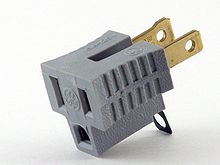
A cheater plug, AC ground lifter or three-prong/two-prong adapter is an adapter that allows a NEMA 5-15P grounding-type plug (three prongs) to connect to a NEMA 1-15R non-grounding receptacle (two slots).[1]: 112 They are needed to allow appliances with 3-wire power cords to plug into legacy ungrounded (two slot) receptacles found in older buildings. The use of such an adapter avoids the need to replace receptacles, but is potentially hazardous if the grounding tab is not connected to electrical ground.[2][3] These adapters are illegal in some jurisdictions, in particular throughout Canada.[4] A safer and more reliable alternative identified in the US and Canadian electrical codes is to replace the outlet with a Ground Fault Circuit Interrupter (GFCI) breaker outlet.[3]
Cheater plugs are also used to break ground loops in audio systems.[5] This practice has been condemned as disregarding electrical safety.[5][6] A safer and more reliable alternative is to use an isolation transformer made specifically for this purpose.
- ^ Cauldwell, Rex (2002). Wiring a House (rev. ed.). Taunton. p. 112. ISBN 1-56158-527-0.
- ^ Binggeli, Corky (2003). Building Systems for Interior Designers. Wiley. p. 233. ISBN 0-471-41733-5.
- ^ a b Cite error: The named reference
mikeholtwas invoked but never defined (see the help page). - ^ Electrical Safety | novascotia.ca
- ^ a b Whitlock, Bill (2005). "Understanding, Finding, and Eliminating Ground Loops in Audio and Video Systems" (PDF). pp. 6–7. Archived from the original (PDF) on 2009-08-24. Retrieved 2010-02-18.
- ^ Ellis, Scott (November 11, 2009). "Diagnosing and Fixing Ground Loops to Prevent AC Hum/Buzz" (PDF). Ebtech Audio. Retrieved May 30, 2010.